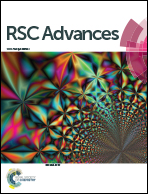Magnetic Fe3O4 nanoparticles supporting Macmillan with controlled shell structure as an efficient and reusable catalyst for asymmetric reaction
Abstract
Magnetic nanoparticles grafted with chiral polymer brushes offer an effective way to bridge the gap between heterogeneous and homogeneous catalysis. Herein, we synthesized a series of chiral catalysts immobilized on magnetic Fe3O4 nanoparticles (MNPs) with a controlled shell structure by an efficient method. This involves the synthesis of “living” Fe3O4 nanoparticles with surface-bound vinyl groups and their subsequent grafting with chiral polymer brushes by the simple RAFT coupling reaction (i.e., chiral polymers with a dithioester end group couple with vinyl groups on the MNPs in the presence of a free radical initiator). The well-defined characteristics of the resulting MNPs allowed the first systematic study of the effects of various structural parameters (the chiral polymer molecular weight and grafting density) on their catalytic performance, which is of great importance for rationally designing more advanced chiral catalyst loading. In particular, the resulting Fe3O4-supported catalysts can effectively catalyze the asymmetric Diels–Alder reaction and can be recycled five times by simple magnetic separation while maintaining activity and selectivity.


 Please wait while we load your content...
Please wait while we load your content...